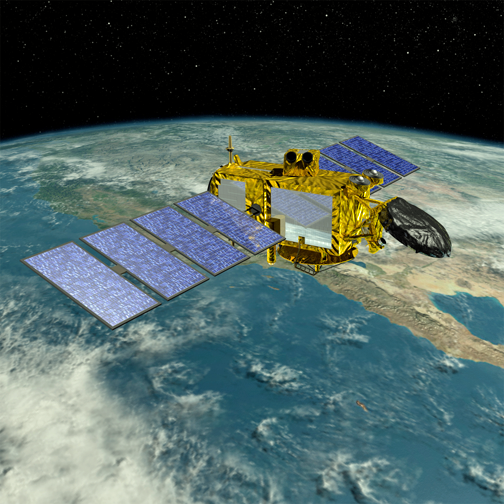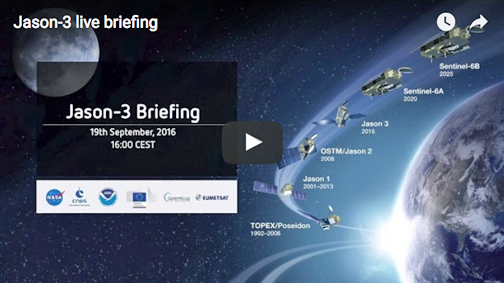
The Jason-3 satellite is the result of an international partnership between EUMETSAT, the French Space Agency (CNES), the US National Oceanic and Atmospheric Administration (NOAA), the US National Aeronautics and Space Administration (NASA), and the European Union, which funds European contributions to Jason-3 operations as part of the European Commission's Copernicus Program.

Artistic rendition of the Jason-3 satellite, courtesy of NASA.
Within Copernicus, Jason-3 is the reference mission for cross-calibrating Sentinel-3 observations of sea surface height and the precursor to the future, cooperative, Sentinel-6/Jason-CS mission, also implemented in partnership between Europe and the United States. EUMETSAT, CNES and NOAA will process data from Jason-3, with EUMETSAT being responsible for data services to users of the EUMETSAT and EU Member States, on behalf of the EU Copernicus Program. Data access in Europe will be secured via the multi-mission infrastructure available at EUMETSAT and CNES, including EUMETSAT’s EUMETCast real-time data dissemination system, Earth Observation Portal and archives, as well as CNES’s AVISO data system.
Now, after a series of re-orbiting maneuvers for Jason-2, a dual Jason capability has been established, increasing the data flow for ocean models through enhanced spatial and temporal sampling of the ocean variables.
After the launch of Jason-3 on January 17, 2016, the two satellites flew in a tandem configuration, about 80 seconds or 500 km apart from each other. This allowed for a precise comparison and direct cross calibration between the instruments flying on both platforms. During this phase, the instruments aboard Jason-3 were fully calibrated and have demonstrated performances at least equivalent to those of Jason-2. Based on these results, the satellite was deemed ready for operational service.
In order to improve sampling and spatial coverage, Jason-2 has now been moved to its final position, on the same orbit but at 162 degrees from Jason-3, thus overflying different ocean surfaces and at a different time than Jason-3. The Jason-3 satellite will continue the long term climate data record on the ground track previously occupied by Topex/Poseidon, Jason-1 and, until recently, Jason-2.
Thanks to their precision, the Jason missions have become the reference for all satellite altimeters, including the Copernicus Sentinel-3A satellite, which was launched on February 16, 2016, and operated by EUMETSAT in cooperation with ESA. Ultimately, Jason-3 will form the backbone of a virtual constellation of ocean altimeter missions.
Josh Willis, NASA Jason-3 project scientist said, "Jason-3 is our window onto the impact of human-caused climate change across the planet. As ocean levels rise due to global warming, the Jason-3 satellite will observe the literal reshaping of more than two-thirds of Earth's surface."
According to Laury Miller, NOAA Jason Program Scientist, Jason-3 will carry the sea level rise monitoring task that is the hallmark of the Jason missions forward, but the continued operation of Jason-2, in combination with Jason-3, adds another critical dimension. Doubling the number of altimeter sea level observations improves the ability to forecast over a range of scales, from the movement of local oil spills to massive El Niño events.
Adding his thoughts, Philippe Escudier, the Oceanography Program Manager of CNES, indicated thatJason-3 will provide essential operational measurements, benefiting from a long series of research and development efforts which allow to reach the necessary measurement accuracy and to optimize the hardware design to make it sustainable in a long term series. In the near term, a new generation of satellite altimetry providing high resolution monitoring will be demonstrated. SWOT, wide swath altimetry mission, which is under development (NASA & CNES), will directly inherit from Jason heritage and will benefit from the absolute accuracy of Jason for the calibration of its measurements.


